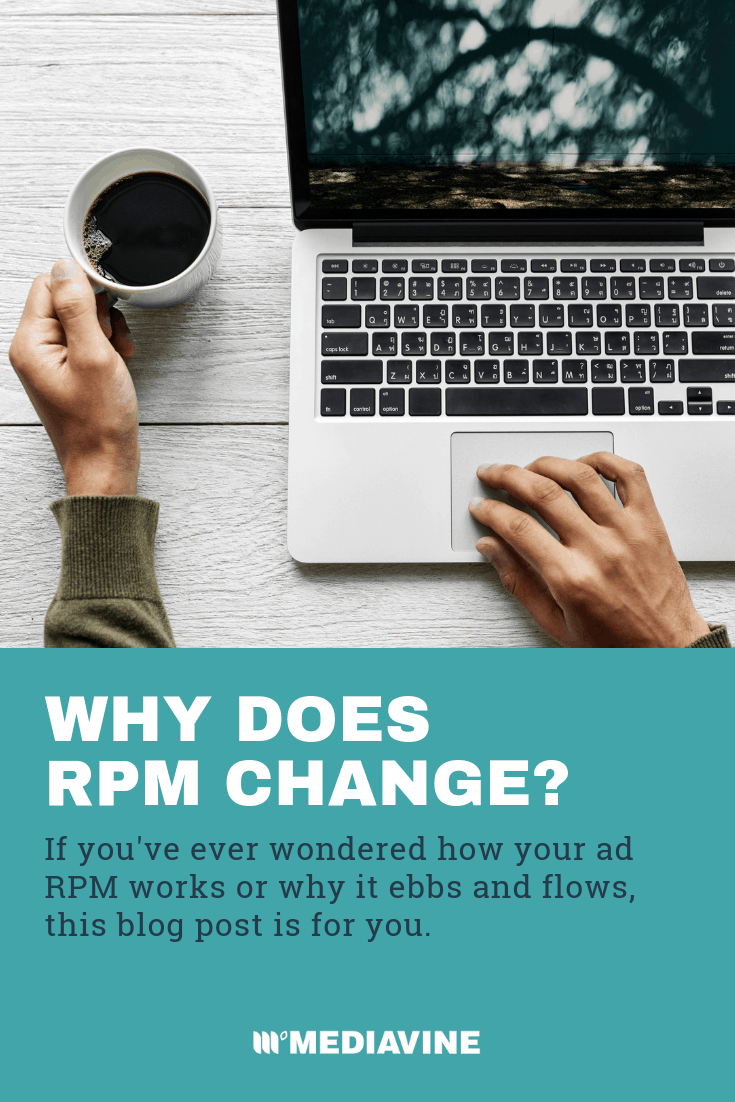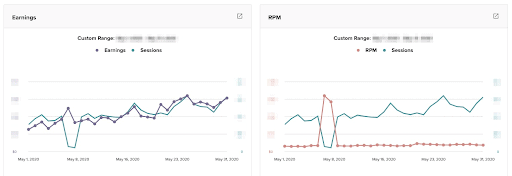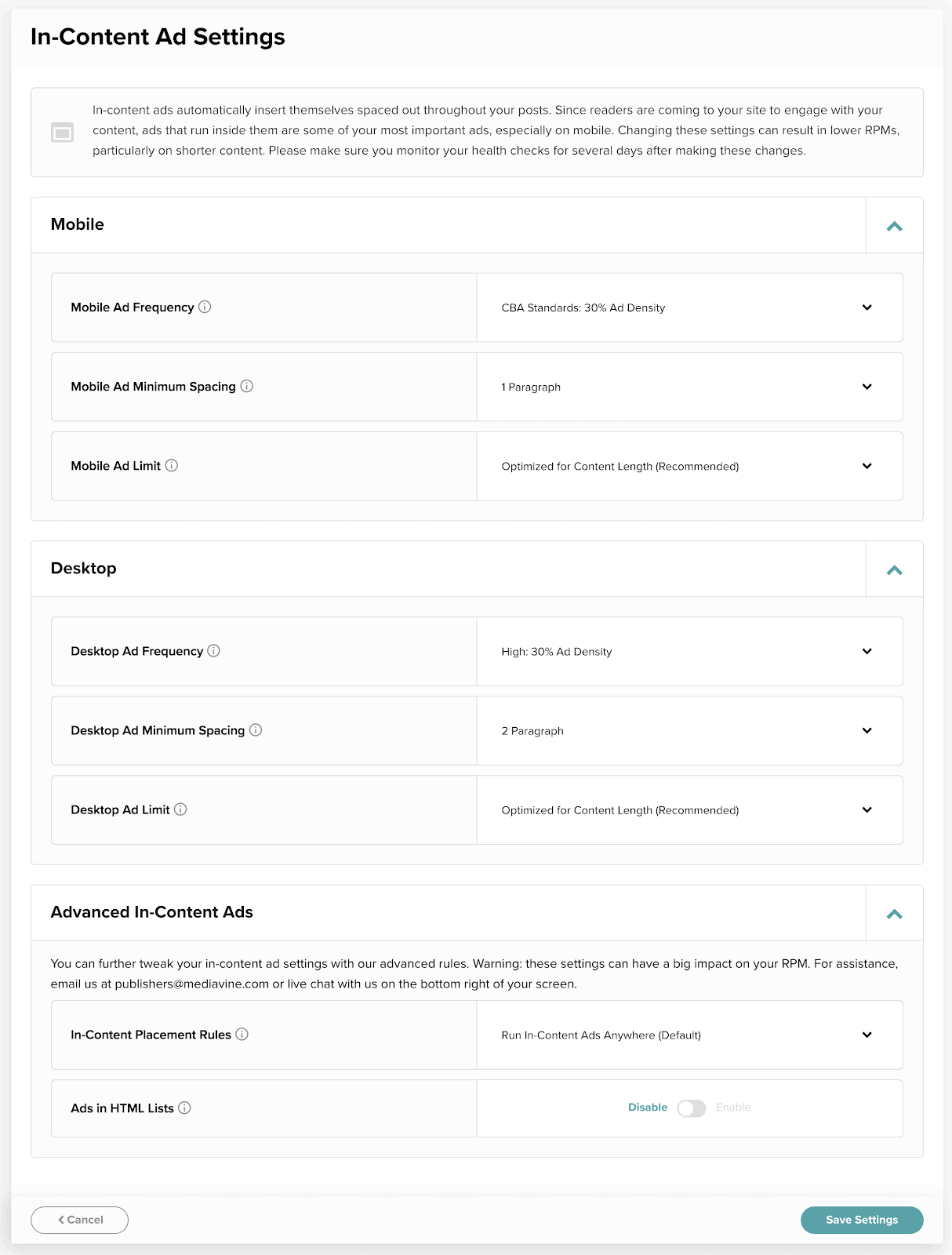- Advertising
Why Does My RPM Change?
•
RPM = Revenue / Sessions * 1000

Why does my RPM change?
RPM changes because one of the values that are included in the calculation, either your sessions or revenue, changes.Why do sessions and revenue change?
Sessions:
Sessions can change for a whole host of reasons. For the RPM discussion here, we’re mostly worried about whether or not your sessions data is ACCURATE. We often see fairly wild RPM changes if the session data being collected isn’t right. This can happen if you have the wrong analytics code installed, if your analytics code isn’t tracking all of your sessions correctly, or if the analytics code is removed from the site. The symptoms of this would be a SUPER CRAZY HIGH RPM listed in your dashboard for the previous day. If that happens, the first thing you want to do is mouse over the entry for that day in the graph, and check to make sure your sessions seem to be in line with what you would expect for that day. If they aren’t, have your managed host or tech help assist you in troubleshooting your analytic implementation.
Common causes of lost analytics connections are:
- Disabling the analytics plugin you use to place the analytics tracking code
- Updating your theme, overwriting your hard-coded tracking
- Changing your analytics account from one UA to another
- Removing the Mediavine analytics connection from the User Management tab of your Analytics admin settings
- Implementing a mobile skin like WP touch, which requires a special tracking code insertion to properly track the mobile statistics

Revenue:
Revenue changes can be due to a lot of different factors. Some are influenced by you, and some are entirely outside of your control. One example of something outside of your control is seasonal ad spend. Sometimes, advertisers are willing to pay more than others for the very same ad on the very same page. That’s usually because demand for that spot in the auction is increased, with more people bidding for that one spot. Demand drives up prices, so that’s why you’ll make more overall for your advertising in December than you do in July, in general. Christmas spending at its peak. Brad wrote a whole post on the seasonality of ad spend, which I HIGHLY recommend. LIGHT BULB moment, when he explained it to me. While there are lots of factors that are outside of our control as publishers when it comes to our revenue, there are even more factors that are well-within our reach, especially with Mediavine ads. One example of a change that is INSIDE of your control that can impact your revenue significantly are your Mediavine Settings.
Mediavine Settings
You have directly in your control the most powerful and comprehensive dashboard available on the market today, hands down, in your Mediavine Publisher Dashboard. Not only can you turn on and off multiple different ad units such as our adhesion units, GumGum in-image units, and Zergnet, but you also have direct control over the frequency, density, and even the placement of your in-content ads as well. We let you opt-out of various ad categories from our biggest partner, Google, and turn on and off our extensive and industry-leading video options as well. Anytime you change your settings, it has the potential to impact your income. If your RPM isn’t as high as you would like it, your Mediavine dashboard is the first place to look.
First, check your Site Health. If you have all TEAL stars, or mostly teal stars, and these metrics haven’t changed much recently, go right to your Settings and check to make sure that you haven’t opted out of more categories than is absolutely necessary for your audience, that you haven’t restricted your in-content ads too much, and that you are taking advantage of all of our amazing Video offerings.
If you don’t have all Teal stars, that’s the best place to start is to work towards that by optimizing your content for ad revenue and SEO. I’d also recommend doing our easy 20-Minute Self-Audit. That’ll give you a great start.
If you run into any trouble or have any questions, you can also reach out to us at the Mediavine Support desk, and we’d be happy to take a look and make any suggestions we have for optimizing your content for earnings.
Anytime you change your settings, it has the potential to impact your income. If your RPM isn’t as high as you would like it, your Mediavine dashboard is the first place to look.
First, check your Site Health. If you have all TEAL stars, or mostly teal stars, and these metrics haven’t changed much recently, go right to your Settings and check to make sure that you haven’t opted out of more categories than is absolutely necessary for your audience, that you haven’t restricted your in-content ads too much, and that you are taking advantage of all of our amazing Video offerings.
If you don’t have all Teal stars, that’s the best place to start is to work towards that by optimizing your content for ad revenue and SEO. I’d also recommend doing our easy 20-Minute Self-Audit. That’ll give you a great start.
If you run into any trouble or have any questions, you can also reach out to us at the Mediavine Support desk, and we’d be happy to take a look and make any suggestions we have for optimizing your content for earnings.

Real World Examples:
Example 1: Your RPM falls from one day to the next from $25 down to $15. First, check your sessions. Are they normal and the expected amount for the day-of-the-week, and time-of-the-year? If not, check your analytics connection. If so, test your ad placement.HOW TO TEST Mediavine AD PLACEMENT
- Open an incognito or private window
- Open up one of your blog posts that was getting a lot of traffic on the day in question.
- Append the following code added onto the end or the URL: ?test=houseads
Common causes of ads not appearing are:
- Mediavine Control Panel was disabled, or the “Insert Script Wrapper” box isn’t checked, or your SITE ID isn’t included in the settings.
- A theme was updated or changed which caused the HTML of the site to change. We target our ads based on different HTML elements of your site, so if those change the ads can not know where they should be.
- You are lazy loading iFrames or Video.
- You are optimizing or minifying our code with a site speed tool or plugin.
Is it the 1st week of the month?
RPMs always dip as advertiser spend decreases during the first week or so of any month. “Normal” amounts of decrease vary, but if you check your site and ads are appearing correctly and your site health is good, and you haven’t made any major site changes, you can be fairly certain it is just typical “1st of the month slump” at play here.Is it January or July?
These months are notoriously bad for ad spend, and will almost always be your lowest performing of the year. If you aren’t sure if it is just typical seasonal shifts or a problem, shoot us as email.Has your site health decreased? Or do you have new trending posts over the last several days?
If your site health scores are going down, that can be a cause for concern. Check your trending content on the day that you are seeing the RPM dip, and see if anything new is creeping up into your top 10 that mayyyybe isn’t as optimized as it could be.Have you changed any settings lately?
As we mentioned above, changing your site’s settings can have an impact on your earnings. If you made some tweaks recently you might want to un-tweak them if the impact is too big on your bottom line. It is always a balance for every site, and where you’ll land might be different than someone else.
Where is your traffic coming from, and how long is it staying?
If you are getting traffic that is hitting one page and the bouncing away relatively quickly, that can be a problem for your pocketbook. Readers will garner the most earnings when they are looking at amazing content, and are engaged with it. They should be hanging out on your page and scrolling as much as possible for ideal results.Where in the WORLD is your traffic coming from?
If you are getting traffic from a different part of the world than is typical for you, it can have an impact on your RPM. Make sure you are running the CMP, which helps with EU traffic monetization.Have you made any speed optimizations to the site?
We are obsessed with pagespeed here, and always encourage everyone to always be working on improvement there, but certain optimizations don’t get along with your ads very well. For instance, don’t lazy load iFrames or Video. Bad news. Also don’t optimize our script in any way. We do all of those optimizations on our end, and any additional optimizations can not only cause your ads to not behave correctly, but it can also put you at risk for GDPR violations. Still stumped? That’s what we’re here for! We’re happy to take a look and double-check that nothing is wrong. We can be reached at publishers@mediavine.com. So you have allll of the pieces now. Your RPM has hills and valleys and patterns, similar to the way your analytics likely do. Just like your overall traffic makeup is determined by factors outside of your control like the calendar, search volumes, user behavior, the whims of the algorithms, etc, as well as factors in your control like user experience, creating amazing content, promoting that content, and using best practices for SEO and marketing, your RPM also has a similar ebb and flow, some of which we can have a direct impact on, and some of which we cannot.
That’s why we are here, and where our mission comes from. To work with you and aid you in building a sustainable, growing, successful business by doing the very best by all of those factors that you CAN impact, while doing all of the heavy lifting behind-the-scenes to make sure that even those factors that are outside of your control are all working as heavily in your favor as they possibly can.
I hope this gives you some insight and some action items to use when trying to figure out what is causing the changes in YOUR RPM.
So you have allll of the pieces now. Your RPM has hills and valleys and patterns, similar to the way your analytics likely do. Just like your overall traffic makeup is determined by factors outside of your control like the calendar, search volumes, user behavior, the whims of the algorithms, etc, as well as factors in your control like user experience, creating amazing content, promoting that content, and using best practices for SEO and marketing, your RPM also has a similar ebb and flow, some of which we can have a direct impact on, and some of which we cannot.
That’s why we are here, and where our mission comes from. To work with you and aid you in building a sustainable, growing, successful business by doing the very best by all of those factors that you CAN impact, while doing all of the heavy lifting behind-the-scenes to make sure that even those factors that are outside of your control are all working as heavily in your favor as they possibly can.
I hope this gives you some insight and some action items to use when trying to figure out what is causing the changes in YOUR RPM.About the author
Share this page